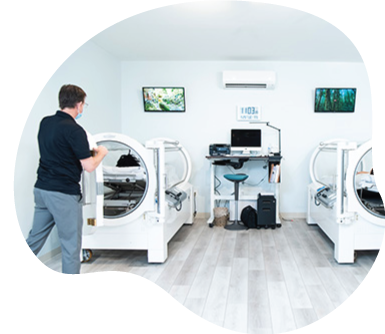Discover the Magic of Hyperbaric Oxygen Therapy: Unveiling the Profound Health Benefits


Grant Ian Gamble is a best-selling mindful leadership author and speaker. He has over 30 years of experience in leading teams to create innovative customer experiences, building engaged workforces, and developing leaders who prioritize mindfulness in their approach.
Hyperbaric oxygen therapy (HBOT) is a medical treatment that involves breathing in pure oxygen while in a pressurized chamber. This treatment has gained popularity in recent years as a complementary therapy for various health conditions. In this article, we will explore what hyperbaric oxygen therapy is and the benefits it offers.
What is Hyperbaric Oxygen Therapy?
Hyperbaric oxygen therapy involves the use of a pressurized chamber to deliver high concentrations of oxygen to the body. During the treatment, the patient lies down inside the chamber and breathes in pure oxygen. The pressure inside the chamber is increased to up to three times the normal atmospheric pressure, which allows the oxygen to dissolve into the bloodstream at a much faster rate.
This increased oxygen delivery to the body has a range of benefits, including improved wound healing, reduced inflammation, and enhanced immune function. Hyperbaric oxygen therapy has been used to treat a variety of health conditions, including carbon monoxide poisoning, decompression sickness, and diabetic foot ulcers.
Benefits of Hyperbaric Oxygen Therapy
- Improved Wound Healing
Hyperbaric oxygen therapy can significantly improve wound healing by increasing the oxygen supply to the affected area. This increased oxygen delivery promotes the growth of new blood vessels and enhances the production of collagen, which are both crucial for wound healing.
- Reduced Inflammation
Hyperbaric oxygen therapy has been shown to reduce inflammation in the body. This is because the high concentrations of oxygen delivered during the treatment can reduce the production of inflammatory molecules and increase the activity of anti-inflammatory cells.
- Enhanced Immune Function
Hyperbaric oxygen therapy can enhance the function of the immune system by increasing the production of white blood cells. This can help the body fight off infections and promote healing.
- Neurological Benefits
Hyperbaric oxygen therapy has been shown to have neuroprotective effects, which means it can protect the brain from damage caused by a lack of oxygen. This treatment has been used to treat conditions such as traumatic brain injury, stroke, and cerebral palsy.
- Anti-Aging Effects
Hyperbaric oxygen therapy has been shown to have anti-aging effects by increasing the production of collagen and reducing the production of free radicals. This can help to reduce the appearance of fine lines and wrinkles and promote overall skin health.
Hyperbaric oxygen therapy is a safe and effective medical treatment that offers a range of benefits for various health conditions. This treatment can improve wound healing, reduce inflammation, enhance immune function, provide neurological benefits, and have anti-aging effects. If you are considering hyperbaric oxygen therapy, it is important to consult with your healthcare provider to determine if it is a suitable treatment option for your specific condition.
Your Ultimate Recovery Guide: Unlocking the Secrets to Peak Performance, Health and Well-being

Put PEOPLE FIRST, ALWAYS and watch your business flourish.
Dive deep into the latest trends in customer experience and team engagement, mindful leadership and management. Discover practical tools and strategies that you can use to build a people-centric culture, the foundation for sustainable long-term business growth and success.
Led by mindful leadership expert, Grant Ian Gamble, a best-selling author and true visionary with over 30 years of experience in leading teams to create innovative customer experiences, building engaged, inspired and fulfilled workforces, and developing leaders who prioritize genuine connection in their approach.
The guiding principle behind all of Grant’s work is PEOPLE FIRST, ALWAYS.
More Articles:
Increase Your Productivity – Gain Traction Amid Endless Distractions
Many of us are working from home for the first time and it’s amazing the distractions that occur throughout the day. Everything from those chores that nag at us through to kids needing help with their online studies. It can often feel like you’re trying to get a lot of things done and none of them seem to get completed as efficiently as you’d like. As we’ve personally watched our kids tackle online school, it’s been fascinating to witness the same thing happening with them.
26 Non-Negotiables, Opportunities & Tips for Surviving and Thriving During and After the COVID-19 Pandemic
The impact of the COVID-19 pandemic on business and the economy is unprecedented.
Businesses negatively affected by COVID-19 are faltering. Even the most robust companies will need to fight their way back to their pre-pandemic best, and marginal ones will likely not re-emerge from the crisis.
Companies positively affected by COVID-19 also need to chart new courses. That might mean establishing new supply chains, recruiting additional talent, or retooling their business to cope with massive spikes in sales and activity.
As businesses recalibrate, strategize, and pivot, one thing remains clear: these are unchartered waters for everyone.
There are some non-negotiables and common denominators across industries and sectors, but for the most part this is a unique set of circumstances that demand novel solutions and strategies.
I have detailed some non-negotiables, opportunities, and tips below:
Change Management During Uncertain Times
I first experienced the joy of sailing as a cadet at the Royal Australian Naval College. Harnessing the power of the wind was both challenging and exhilarating. Since those days of sailing Bosun’s Dinghies around Jervis Bay, I’ve sailed everything from windsurfers and kiteboards all the way up to a 48-foot catamaran on the Great Barrier Reef in Australia.
Fill out the form below and receive a PDF download of "6 Key Strategies to Engage Untapped Fitness and Wellness Market Segments"
Please check your email for a link to your PDF download of "6 Key Strategies to Engage Untapped Fitness and Wellness Market Segments." Don't forget to check your Spam or Promotions folder and add Grant Ian Gamble to your email contacts.
Let's Connect!
CUSTOMER EXPERIENCE, TEAM ENGAGEMENT & WORKPLACE WELL-BEING: AFFINITY OS™ | WELLNESS INTEGRATION | MINDFUL LEADERSHIP: "THE AFFINITY PRINCIPLE"
0475 866 592

The Affinity Principle™ by Grant Gamble presents a formula for business success through a people-centric, mindful leadership approach.
PEOPLE FIRST, ALWAYS.








